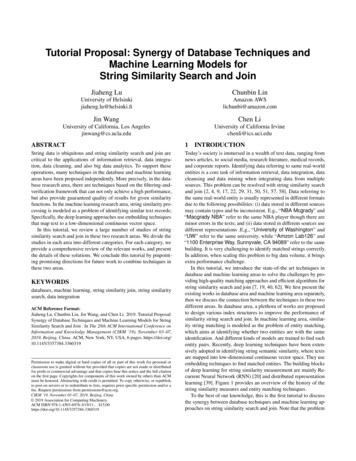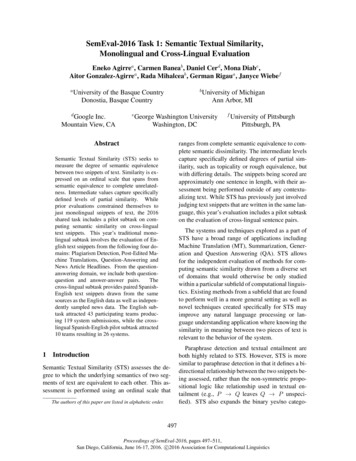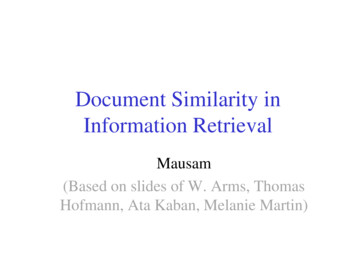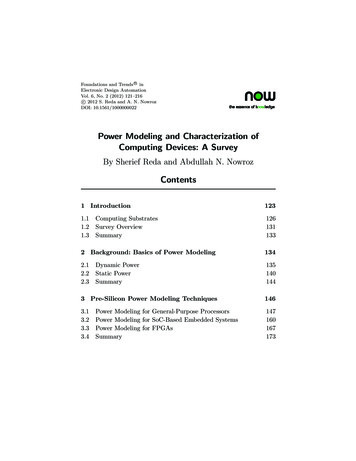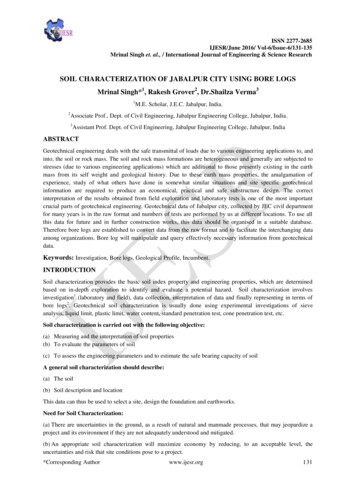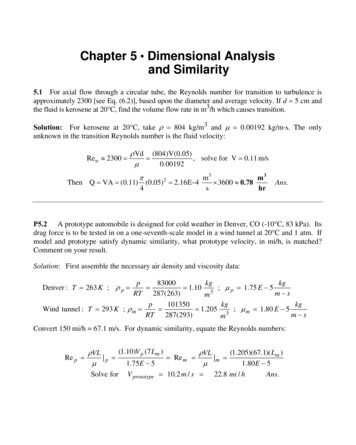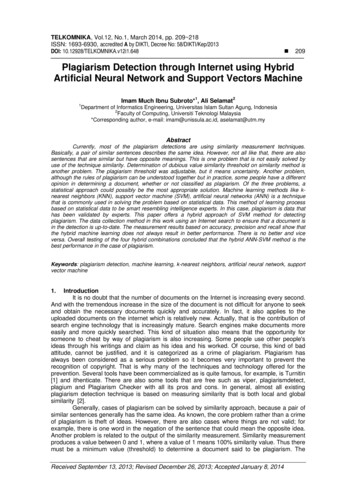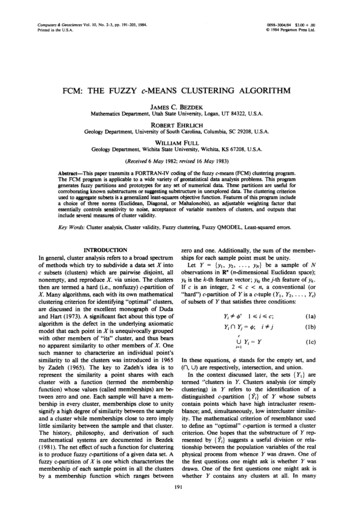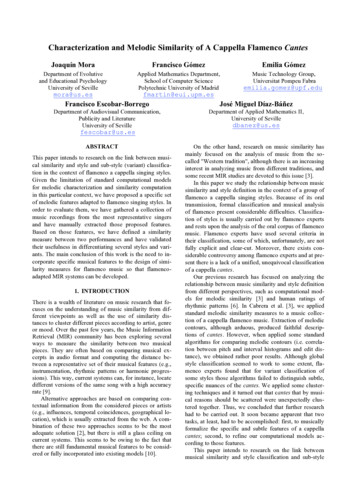
Transcription
Characterization and Melodic Similarity of A Cappella Flamenco Cantes!Joaquín MoraFrancisco GómezEmilia GómezDepartment of Evolutiveand Educational PsychologyUniversity of SevilleApplied Mathematics Department,School of Computer SciencePolytechnic University of MadridMusic Technology Group,Universitat Pompeu eduFrancisco Escobar-BorregoJosé Miguel Díaz-BáñezDepartment of Audiovisual Communication,Publicity and LiteratureUniversity of SevilleDepartment of Applied Mathematics II,University of Sevillefescobar@us.esABSTRACTThis paper intends to research on the link between musical similarity and style and sub-style (variant) classification in the context of flamenco a cappella singing styles.Given the limitation of standard computational modelsfor melodic characterization and similarity computationin this particular context, we have proposed a specific setof melodic features adapted to flamenco singing styles. Inorder to evaluate them, we have gathered a collection ofmusic recordings from the most representative singersand have manually extracted those proposed features.Based on those features, we have defined a similaritymeasure between two performances and have validatedtheir usefulness in differentiating several styles and variants. The main conclusion of this work is the need to incorporate specific musical features to the design of similarity measures for flamenco music so that flamencoadapted MIR systems can be developed.1. INTRODUCTIONThere is a wealth of literature on music research that focuses on the understanding of music similarity from different viewpoints as well as the use of similarity distances to cluster different pieces according to artist, genreor mood. Over the past few years, the Music InformationRetrieval (MIR) community has been exploring severalways to measure the similarity between two musicalpieces. They are often based on comparing musical excerpts in audio format and computing the distance between a representative set of their musical features (e.g.,instrumentation, rhythmic patterns or harmonic progressions). This way, current systems can, for instance, locatedifferent versions of the same song with a high accuracyrate [9].Alternative approaches are based on comparing contextual information from the considered pieces or artists(e.g., influences, temporal coincidences, geographical location), which is usually extracted from the web. A combination of these two approaches seems to be the mostadequate solution [2], but there is still a glass ceiling oncurrent systems. This seems to be owing to the fact thatthere are still fundamental musical features to be considered or fully incorporated into existing models [10].dbanez@us.esOn the other hand, research on music similarity hasmainly focused on the analysis of music from the socalled "Western tradition", although there is an increasinginterest in analyzing music from different traditions, andsome recent MIR studies are devoted to this issue [3].In this paper we study the relationship between musicsimilarity and style definition in the context of a group offlamenco a cappella singing styles. Because of its oraltransmission, formal classification and musical analysisof flamenco present considerable difficulties. Classification of styles is usually carried out by flamenco expertsand rests upon the analysis of the oral corpus of flamencomusic. Flamenco experts have used several criteria intheir classification, some of which, unfortunately, are notfully explicit and clear-cut. Moreover, there exists considerable controversy among flamenco experts and at present there is a lack of a unified, unequivocal classificationof a cappella cantes.Our previous research has focused on analyzing therelationship between music similarity and style definitionfrom different perspectives, such as computational models for melodic similarity [3] and human ratings ofrhythmic patterns [6]. In Cabrera et al. [3], we appliedstandard melodic similarity measures to a music collection of a cappella flamenco music. Extraction of melodiccontours, although arduous, produced faithful descriptions of cantes. However, when applied some standardalgorithms for comparing melodic contours (i.e. correlation between pitch and interval histograms and edit distance), we obtained rather poor results. Although globalstyle classification seemed to work to some extent, flamenco experts found that for variant classification ofsome styles those algorithms failed to distinguish subtle,specific nuances of the cantes. We applied some clustering techniques and it turned out that cantes that by musical reasons should be scattered were unexpectedly clustered together. Thus, we concluded that further researchhad to be carried out. It soon became apparent that twotasks, at least, had to be accomplished: first, to musicallyformalize the specific and subtle features of a cappellacantes; second, to refine our computational models according to those features.This paper intends to research on the link betweenmusical similarity and style classification and sub-style
(variant) definition in the context of flamenco a cappellasinging styles. The main contributions are (1) Identifyrelevant and specific features that characterize a givenperformance in the context of its style. Here, we considerthat each style is characterized by a prototypical melodiccontour. The features will then account for variationswithin this contour. (2) Define a similarity measure basedon the identified features and provide an automaticmethod of clustering and classification. (3) Evaluate theresults with a music collection of recordings from themost representative performers and contrast them withexisting theories for the definition of styles and variants.This paper is organized as follows. In the next twosections we analyze the characteristics of flamenco singing and a cappella cantes. Next we give an overview ofthe cantes to be analyzed and we describe the music collection used in our study. We then present the set of features that describes the two chosen cantes, namely, deblas and martinetes. The following section deals with thesimilarity distance between cantes. A conclusion sectionsummarizes the main findings and presents some proposals for future research.Classification of a cappella cantes is subject to many difficulties. Two cantes belonging to the same style maysound very different to an unaccustomed ear. In general,underlying each cante there is a melodic skeleton.Donnier [4] called it the “cante’s melodic gene”. Thesinger fills this melodic skeleton by using different kindof melismas, ornamentation and other expressive resources. A flamenco aficionado recognizes two versionsas to be the same cante because certain notes appear incertain order. What happens between two of those notesdoes not matter regarding style classification, but doesmatter for assessing a performance or the piece itself.Aficionado’s ears recognize the wheat from the chaffwhen listening and appreciate a particular performance interms of the quality of the melodic filling, among otherfeatures.In order to put the reader in the position of understanding this point, in Figures 1 and 2 we show a transcription of two versions of the same cante to Westernmusical notation. In this respect, Western notation hasbeen found limited for this kind of music (e.g. Donnier[4] proposed the use of plainchant neumes).2. FLAMENCO SINGINGWe now describe the main features that characterize flamenco singing and differentiate it from other styles:- Instability of pitch. In general, notes are not clearlyattacked. Pitch glides or portamenti are very common.- Sudden changes in volume (loudness).- Short pitch range or tessitura. It is normally limited toa major sixth interval and characterized by the insistenceon a note and those contiguous.- Intelligibility of voices. Since lyrics are important inflamenco, there is a strong preference for intelligibilityover range or timbre. Contralto and baritone voices arevery common.- Timbre. Timbre characteristics of flamenco singers depend on the period in which it was performed. As relevant timbre aspects, we can mention breathiness in thevoice and the absence of high frequency (singer) formant,which is characteristic of classical singing styles.Figure 1: Manual transcription of a cante (debla).From a musical point of view, a cappella cantes retain thefollowing properties.- Conjunct degrees. Melodic movement mostly occursby conjunct degrees.- Scales. Certain scales such as the dominant Phrygianmode (with a major tonic) and Ionian mode (E-F-G#-AB-C-D) are predominant.- Ornamentation. There is also a high degree of complexornamentation, melismas being one of the most significant devices of expressivity.- Microtonality. The use of intervals smaller than theequal-tempered semitones of Western classical music isfrequent.- Enharmonic scales. Microtonal interval differences between enharmonic notes.Figure 2: Transcription of another version of the previouscante.3. THE STYLES OF TONÁSAs defined earlier, a cappella cantes are songs withoutinstrumentation, or in some cases with some percussion(in the flamenco argon also cantes a palo seco). An important group of such cantes is composed of tonás, stylethat generically include martinetes, deblas, saetas, tonásand carceleras. Since in flamenco music the word tonárefers to both the style and one of its variants, we will refer to “tonás style” as the whole style and toná as the substyle or cante.
These cantes are played in free rhythm (sometimesthe pattern of seguiriya is used as rhythmic accompaniment). Each singer chooses his or her own referencepitch. Modality, depending on the particular style, may beeither the major mode or the Andalusian mode (Phrygianmode with a tonic major chord), though frequently bothmodes alternate within the same song [5]. Lyrics of thesesongs range widely. Lefranc [8] carried out a classification of the tonás style mainly based on lyrics. Blas Vega[1] also studied the tonás style from a historical standpoint. A toná typically possesses verses formed by wordseither of three or four syllables, or eight syllables, wherethe second and the forth verses may have assonant rhyme;often the final verse finishes with an imperfect tercet (atercet is a group of three lines of a verse; an imperfecttercet is an off-rhyme tercet).The toná cante is normally sung in a four-verse formof eight syllables each. Rhyme is assonant on evenverses. The toná cante appears in several modes, thePhrygian mode being the most prevailing one. Ionian orAeolian modes can also be found as well as alternation oftwo modes. Ornamentation is very complex and profuse;no strict tempo is followed at all.4. MUSIC COLLECTIONTo start with, we gathered a set of 365 pieces belongingto the tonás style. Somehow, these cantes have scarcelybeen recorded compared to other styles. Their ritual moodand lyricism might be a plausible reason for that shortageof recordings. In spite of that, we spared no effort togather as many recordings as possible from all feasiblesources (private collections, libraries, historical recordings, several institutions, etc.). We may safely state thatour collection is quite representative of this type of cantes.After the analysis phase of the corpus, we decided tofocus on two styles, deblas and martinetes, because: (1)Both styles are central to flamenco music; (2) Contrary toother cantes, we had information about singers, geographical locations, singing schools, dates, etc., whichallows us to have a complete, in-depth characterization ofthem from a more general standpoint than just the musical one; (3) In general, recordings had acceptable qualityto carry out this research and the future ones, which include, for instance, automatic feature extraction fromaudio files; (4) There was a high number of recordings,72 songs in total, where 16 were deblas and 56 martinetes; (5) Apart from the number, there was enough variability in the sample for a proper evaluation of our methods.The specific feature set of deblas and martinetes1, tobe described below, were obtained after a thorough study.First, we opened an analysis phase to identify which musical features were relevant to the characterization of thechosen cantes. Preliminary analysis produced too manyvariables or just variables with little explanatory power.Next, in search of the least complex yet meaningful de1The music collection studied in this paper can be found athttp://mtg.upf.edu/research/projects/cofla Please, contact the authors.scription of cantes, we removed several variables. Mostof the features identified were related to melody andform. During the analysis, in our mind it also underlaythe idea of capturing some of the features used by flamenco experts and aficionados to recognize the differentstyles. After deciding on the final feature set, we manually extracted it for the different performances. A working group of flamenco experts agreed on the proposedfeature set and annotations. The next two sections describe the musical features in detail.5. MUSICAL FEATURES5.1. DeblasThe debla is a song from the style of tonás. In general, itis marked by its great melismatic ornamentation, moreabrupt than the other songs from this style, which characterizes its melody. Deblas are characterized by a particular melodic contour.The musical features that characterize the differentvariants within the debla style can be summarized as follows:1. Beginning by the word ¡Ay!: ¡Ay! is an interjectionexpressing pain, which is quite idiosyncratic to flamenco music. Values of the variable: Yes and no.2. Linking of ¡Ay! to the text. That initial ¡Ay! may belinked to the text or just be separated from it. Valuesof the variable: Yes and no.3. Initial note. It refers to the first note of the tercet.Normally, it is the sixth degree of the scale (VI), butthe fifth degree (V) can also appear. Values of thevariable are 5 and 6.4. Direction of melody movement in the first hemistich (a hemistich is half of a line of a verse.) The direction can be descending (fast appoggiatura in V,then the progression VI-IV), symmetric (III-VI-IV) orascending. Values here are D, S and A.5. Repetition of the first hemistich. That repetitionmay be of the whole hemistich or just a part of it.Values of the variable: Yes or no.6. Caesura. The caesura is a pause that breaks up averse into two hemistiches. Values of the variable:Yes and no.7. Direction of melody movement in the second hemistich, defined as in the first hemistich. Values of thevariables are D, S and A.8. Highest degree in the second hemistich. It is thehighest degree of the scale reached in the secondhemistich. Usually, the seventh degree is reached, butfifth and sixth degrees may also appear. Values of thevariable are 5, 6 and 7.9. Frequency of the highest degree in the secondhemistich. The commonest melodic line to reach thehighest degree of the scale consists of the concatenation of two torculus. A torculus is a neume signifyingthree notes, the second higher than the others. Thevalue of this variable indicates how many times thisneume is repeated in the second hemistich.
10. Duration. Although the duration is measured in ms,our intention was to classify the cantes into threecategories, fast, regular and slow. To do so, we firstcomputed the average ! and the standard deviation !of the durations of all the cantes in the same style.Then, fast cantes are those whose duration is less than!-!, regular cantes have their duration in the interval[!-!, ! !], and slow cantes have durations greaterthan ! !. Values of this variable are F, R and S.5.2. MartinetesThe martinete is also considered a variant of the toná. Itdiffers from deblas in the theme of its lyrics and in itsmelodic model, which always finishes in the major mode.Debla’s mood is usually sad, played without guitar accompaniment, like the other tonás. Martinetes, however,are usually accompanied by the sound of a hammer struckagainst an anvil.There are three clear variants of martinetes. The firstone, to be called martinete 1, has no introduction,whereas the second one, to be called martinete 2, startswith a couple of verses from a toná. The third one, to becalled martinete 3, is a concatenation of a toná and someof the previous variants of martinetes; the toná of martinete 2 and 3 is called toná incipit. A trait of martinete 3 isthe singing of several poems, all having the same themeas in medieval romances. Because martinete 3 is a combination of toná and martinetes 1 and 2, we removed itfrom our current study, as we just sought characterizingthe most fundamental styles.Next, musical features of martinete 1 are presented.1. Repetition of the first hemistich. As for deblas,repetition may be complete or partial. Values of thevariable: Yes and no.2. Clivis/flexa (a neume of two notes, the second lowerthan the first one) at the end of the first hemistich.Normally, fall IV-III or IV-IIIb are found. The commonest ending for a tercet is the fourth degree, whosesound is sustained until reaching the caesura. Somesingers like to end on III or IIIb. Values of the variable are: Yes and no.3. Highest degree in both hemistiches. The customarypractice is to reach the fourth degree; some singersreach the fifth degree. Values of the variable are 4 and5.4. Frequency of the highest degree in the secondhemistich. The melodic line is formed by a torculus,a three-note neume, III-IV-III in this case. This variable stores the number of repetitions of this neume.5. Final note of the second hemistich. The secondhemistich of martinete 1 is ended by falling on thesecond degree. Sometimes, the second degree is flattened, which produces Phrygian echoes in the cadence. This variable takes two values, 1 when the final note is the tonic and 2 when the final note is II.6. Duration. This variable is defined as in the case ofdeblas (that is, in terms of ! and !). Values of thisvariable are F, R and S.As for martinete 2 we have the following features.1. Highest degree in both hemistiches. In this case thecustomary practice is to reach the sixth degree; insome cases singers just reach the fourth or fifth degrees. Values of the variable are 4, 5 and 6.2. Frequency of the highest degree in the secondhemistich. In this case the neume is also a torculus.This variable stores the number of repetitions of thisneume.3. Symmetry of the highest degree in the secondhemistich. The second hemistich of a martinete 2 isrich in melismas. This feature describes the distribution of the melismas around the highest reached degree, which is usually the sixth degree. Melismas canoccur before and after reaching the highest degree(symmetric distribution), only before the highest degree (left asymmetry) or only after the highest degree(right asymmetry).4. Duration. This variable is defined as in the previouscases. Values of this variable are F, R and S.6. SIMILARITY COMPUTATION6.1 Inter-Style SimilarityCarrying out the preceding analysis allowed us to extracta set of musical features to be used in the definition ofmelodic similarity between cantes. As a matter of fact,just using features very peculiar to a given style woulddistort the analysis, as their discriminating power wouldbe very high. Our intention was to select a set of a fewfeatures capable of discriminating between differentcantes. We removed those variables that only made sensewithin one style, gathering the following final set:1. Mode of type of scale: Ionian (major mode), dominant Phrygian (Phrygian mode with a major third) orbimodal (alternation of both modes). This variablemakes sense to classify the different styles.2. Direction of melody movement in the first hemistich.3. Symmetry of the highest degree in the secondhemistich.4. Clivis (or flexa) at the end of the first hemistich.5. Repetition of the first hemistich.6. Initial note.7. Final note of the second hemistich.8. Highest degree in both hemistiches.9. Frequency of the highest degree in the secondhemistich with respect to a cante. This variable hasbeen normalized as follows. Let ! be the average ofthe frequencies of the all cantes, and ! its standarddeviation. The frequency takes three values, 0 (seldom), if the frequency is less than !-!; 1 (normal) if itis within the interval [!-!, ! !]; and 2 (often), whenit is greater than ! !.10. Frequency of the highest degree in the secondhemistich with respect to the whole corpus. In this
case the mean and the standard deviation are takenwith respect to all pieces in the corpus.11. Duration with respect to the piece. This variable isdefined as above, taking three values fast, regular andslow.12. Duration with respect to the whole corpus. Now themean and the standard deviation are computed for thewhole corpus.puted the corresponding distance matrices and generatedtheir phylogenetic trees. As before, we used the Euclidean distance. Again, our intention was to evaluate howwell the defined features characterize these cantes.Note that some of these variables do not appear asspecific features in some cante. We removed those variables that only accounted for one cante and tried to keepthe smallest set of explanatory variables. Moreover, weperformed a principal component analysis (SPSS 15 wereused for this). As a consequence, two variables were discarded: Clivis (or flexa) at the end of the first hemistichand repetition of the first hemistich. The number of finaldimensions turned out to be 3 and the Cronbach’s alphaequalled 0.983, a very good value, indeed.The distance we used to measure the similarity between two cantes was the simplest one could think of: theEuclidean distance between features vectors. Our intention was to test how powerful the musical features wouldbe. The Euclidean is just a geometrical distance and doesnot reflect perceptual distance whatsoever. However, because of the robustness and power of the musical features, results were good.We used phylogenetic trees [7] to better visualizethe distance matrix. For the actual computing, we usedthe tool SplitsTree [7]. SplitsTree computes a tree (ormore generally a graph) with the property that the distance in the drawing between any two nodes reflects asclosely as possible the true distance between the corresponding two pieces in the distance matrix. In general,clustering and other properties are easier to visualize withphylogenetic trees.Regarding style classification, Figure 2 displays thephylogenetic tree obtained for the whole corpus understudy. Label Dx stands for debla, label M1 stands formartinete 1 and label M2 for martinete 2.As it can be noticed, discrimination among cantes isvery good. There are three clearly separated clusters, eachcorresponding to a cante.In addition, we have computed for each cante its closest neighbour and checked if both belong to the samestyle. That was the situation for 88.6% of the cases. Therewas a striking case in one particular debla. Debla D2-14whose three nearest neighbours turned out to be of classmartinete 2. That debla is one of the oldest known songs,according to our musicological knowledge. Meaningfullyenough, the closest martinetes are also old, which suggests a possible common origin or an evolution of martinete 2 from debla (martinete 2 seems to be a mixture ofprevious cantes). Those martinetes are M2-66, M2-68 andM2-65; see Figure 3 at the end of this paper.We also observed that some distance values wereequal to zero for the same style; this will be discussedlater in the conclusions section. Finally, precision and recall, two common performance measures, curves are provided in Figure 4.6.2 Intra-Style SimilarityOn a second step, we analyzed similarities between performances within each particular style. In this case, weconsidered all the variables presented below for each particular style (martinete1, martinete2 or debla). We com-7. RESULTS7.1 Inter-Style Similarity7.2 Intra-Style SimilarityWe did not expect a very fine clustering in the intra-stylecase, as the musical features account for general properties rather than for specific properties. In general, therewas one big cluster, often with several cantes having thesame distances. Overall, this was in general coherent tothe expert’s knowledge on the musical relation amongperformers.Figure 3: A phylogenetic graphfor the whole corpus.
have proved they work quite well for inter-style classification. Our approach can be easily adapted to build aclassification system based on machine learning. For thecase of intra-style classification, more musical featuresshould be identified. Our goal was to distinguish generalmusical features rather than specific features. This situation shows that special needs require special treatmentsand that inter-style and intra-style classification needs adifferent set of musical features.At present all the work put forward here has beendone in a manual way. First, we wanted to check that theextraction of the musical features were correct and, furthermore, gave a good measure of similarity. We are currently working on building an automatic system based onour measure. This includes the automatic extraction of themusical features from music recordings through an automatic transcription procedure.Precision vs e 4: Precision versus recall for style classification.8. CONCLUSIONSThere are many automatic systems that compute similarity between pieces of music by measuring the distancebetween some musical features. One common feature isthe melodic contour. Therefore, the problem of measuringmusical similarity is transformed into the problem ofcomputing distances between melodic contours. For certain type of music that approach may be appropriate andeven produce good results. It is not the case for flamencoa cappella flamenco cantes, a kind of music characterizedby very special features. In our previous study [3] we followed that approach and understood its drawbacks. Reducing melodic similarity to computing the distance between melodic contours leaves significant variables aside,which results in a limited similarity measure.In the present study we took another approach. Weidentified a set of musical features as basis for our measure. Those musical features are related to melodic properties, duration and form and reflect in general high-levelcharacteristics of the cantes. We also found some limitations. As the reader may have noticed, many cantes givethe same feature vector and, therefore, in the phylogenetic trees they all appear on the same node. Why is thatso? A moment’s thought will reveal that this situation isnot as surprising as it might seem at first glance. As wementioned, the musical features account for high-levelcharacteristics. Two cantes may be different at the finedetail level and yet have the same musical features. Thatis the hardness of dealing with flamenco cantes.It is clear that in order to obtain good similaritymeasures musical knowledge of the particular type ofmusic must be incorporated into the model. On the otherhand, since we know this is not enough, fine detail information such as melodic contours should be incorporated,too. Thus, there should be a tradeoff between both approaches. That is the research we are presently carryingout.The identification of the musical features of a cappella cantes is one of the main contributions of this paper.They have not been described before and our experiments9. REFERENCES[1] Blas-Vega, J Historia de las tonás, ed. Guadalhorce,Málaga, 1967.[2] Celma, O. Music Recommendation and Discovery inthe Long Tail. PhD thesis, Universitat Pompeu Fabra,2008.[3] Cabrera, J.J., Díaz-Báñez, J.M., Escobar, F.J., Gómez,E., Gómez, F., Mora, J. Comparative Melodic Analysis of A Cappella Flamenco Cantes. In Conference onInterdisciplinary Musicology. Thessaloniki, Greece,2008.[4] Donnier, P. Flamenco: elementos para la transcripción del cante y la guitarra, Proceedings of the IIIrdCongress of the Spanish Ethnomusicology Society,1997.[5] Fernández, L. Flamenco Music Theory. AcordesConcert. 2004.[6] Guastavino, C., Gómez, F., Toussaint, G., Marandola,F., Gómez, E. Measuring Similarity between Flamenco Rhythmic Patterns. Journal of New Music Research. 38(2), 129-13, 2009.[7] Huson, D. H. SplitsTree: Analyzing and visualizingevolutionary data, Bioinformatics, 14:68-73, 1998.[8] Lefranc, P. El Cante Jondo. Del territorio a losrepertorios: tonás, seguiriyas, soleares. Publicacionesde la Univ. de Sevilla, Cultura Viva, Vol. 16, 2000.[9] Serrá, J., Gómez, E., Herrera, P., and Serra, X.Chroma Binary Similarity and Local Alignment Applied to Cover Song Identification. IEEE Transactionson Audio, Speech and Language Processing, Vol.16(6), pp. 1138-1151, 2008.[10] Widmer, G., Dixon, S., Knees, P., Pampalk, E.Pohle, T. From Sound to Sense via Feature Extractionand Machine Learning: Deriving High-Level Descriptors for Characterizing Music, in Sound to Sense,Sense to Sound: A State of the Art in Sound and Music Computing, Chapter 5, 2008.Acknowledgements: This research has been partiallyfunded by the Junta de Andalucía COFLA project (P09TIC-4840).
and Educational Psychology University of Seville mora@us.es Applied Mathematics Department, School of Computer Science Polytechnic University of Madrid fmartin@eui.upm.es Music Technology Group, Universitat Pompeu Fabra emilia.gomez@upf.edu Francisco Escobar-Borrego Department of Audiovisual Communication, Publicity and Literature
